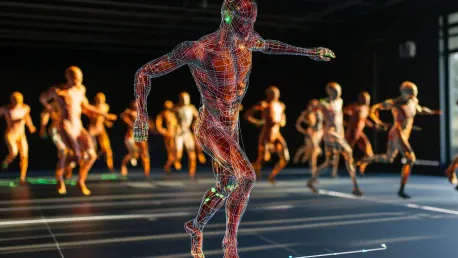The longstanding challenges associated with traditional motion capture techniques have been addressed by researchers at CAMERA, the University of Bath’s Center for Analysis of Motion, Entertainment, and Research Applications. By creating open-access software for analyzing motion capture data without markers, they aim to revolutionize how clinicians, sports coaches, and physiotherapists work with movement analysis. Typically, motion analysis involves using light-reflective markers, which not only require lengthy setup times but also often impede natural movement. The transition to a markerless system represents a significant breakthrough in the field.
The Birth of Markerless Motion Capture
Leveraging Computer Vision and Deep Learning for Precision
Developed by a team led by Dr. Steffi Colyer, this innovative markerless motion capture system leverages cutting-edge computer vision and deep learning techniques to identify body landmarks from 2D images. By employing software like OpenPose and OpenSim, the researchers successfully estimated joint positions and reconstructed 3D body motions from simple 2D video footage. This approach not only matches the accuracy of traditional marker-based techniques but also provides a more convenient and non-invasive method of capturing motion data.
The primary advantage of this system is its ability to capture motion without interfering with the subject’s natural movements. Clinicians and sports professionals have long sought a method that wouldn’t hinder athletes or patients by requiring them to wear cumbersome markers. The ability to measure motion seamlessly and unobtrusively opens up new possibilities in fields ranging from sports performance analysis to rehabilitation. Furthermore, it facilitates data collection in real-world environments, beyond the confines of laboratory settings.
Diverse Applications and Testing of the New System
The efficacy of the markerless motion capture system has been rigorously tested on various activities, including running, jumping, and walking. These tests not only demonstrated the system’s capability to provide accurate motion data but also highlighted its practicality across a wide range of applications. By removing the barrier posed by traditional marker-based methods, the new system offers a powerful tool to improve sports performance, prevent injuries, and aid in rehabilitation processes.
Additionally, the project incorporated a unique dataset that researchers can use to further refine and enhance markerless algorithms. This open-source dataset serves as a valuable resource, fostering collaboration and continuous advancements in both computer vision and biomechanics. As a result, the community of researchers and professionals working in these fields can benefit from this innovative approach, leading to more precise and practical motion analysis solutions.
Benefits and Implications for Future Research
Enhancing Accessibility and Practicality in Motion Capture
One of the most significant benefits of the markerless motion capture system is its potential to democratize access to high-quality motion analysis. Markers and sophisticated laboratory settings have traditionally limited motion capture to well-funded institutions or specific professional applications. With the markerless system, the barriers to entry are significantly lowered, enabling more widespread use in various domains.
This improved accessibility is particularly beneficial for sports coaches and physiotherapists working in diverse settings. It allows for the collection of accurate motion data in natural environments, leading to more relevant insights and practical interventions. For instance, analyzing an athlete’s performance on the field or monitoring a patient’s rehabilitation progress at home can now be done with greater ease and precision. Such versatility underscores the potential of the markerless system to enhance the effectiveness of training and treatment strategies.
Driving Innovation in Biomechanics and Beyond
The open-source nature of the motion capture pipeline and data signifies a considerable leap forward for the research community. It encourages continuous innovation and collaboration, as researchers can build on existing work, share insights, and develop more advanced algorithms. This collaborative spirit is essential for pushing the boundaries of what is possible in motion capture and biomechanics.
The research, published in Scientific Data – Nature, marks a pivotal advancement in the field of motion capture. It presents a new toolset that can be applied in numerous contexts, from entertainment and sports to healthcare and scientific research. By providing a non-invasive, cost-effective, and highly accessible solution, the markerless motion capture system paves the way for new discoveries and improvements in understanding human movement.
Conclusion
Researchers at CAMERA, the University of Bath’s Center for Analysis of Motion, Entertainment, and Research Applications, have tackled the longstanding challenges associated with traditional motion capture techniques. By developing open-access software for analyzing motion capture data without the need for markers, they aim to revolutionize the way clinicians, sports coaches, and physiotherapists work with movement analysis. Typically, motion analysis relies on light-reflective markers, which not only require extensive setup times but also often restrict natural movement. This new software can capture motion data without the use of markers, resulting in a more efficient and less intrusive process. The transition to a markerless system represents a significant breakthrough in the field, as it allows for more natural and accurate tracking of movements. Consequently, this innovation has the potential to greatly enhance the work of professionals in various fields that rely on precise movement analysis, making the process faster and more user-friendly while ensuring accurate data collection.









